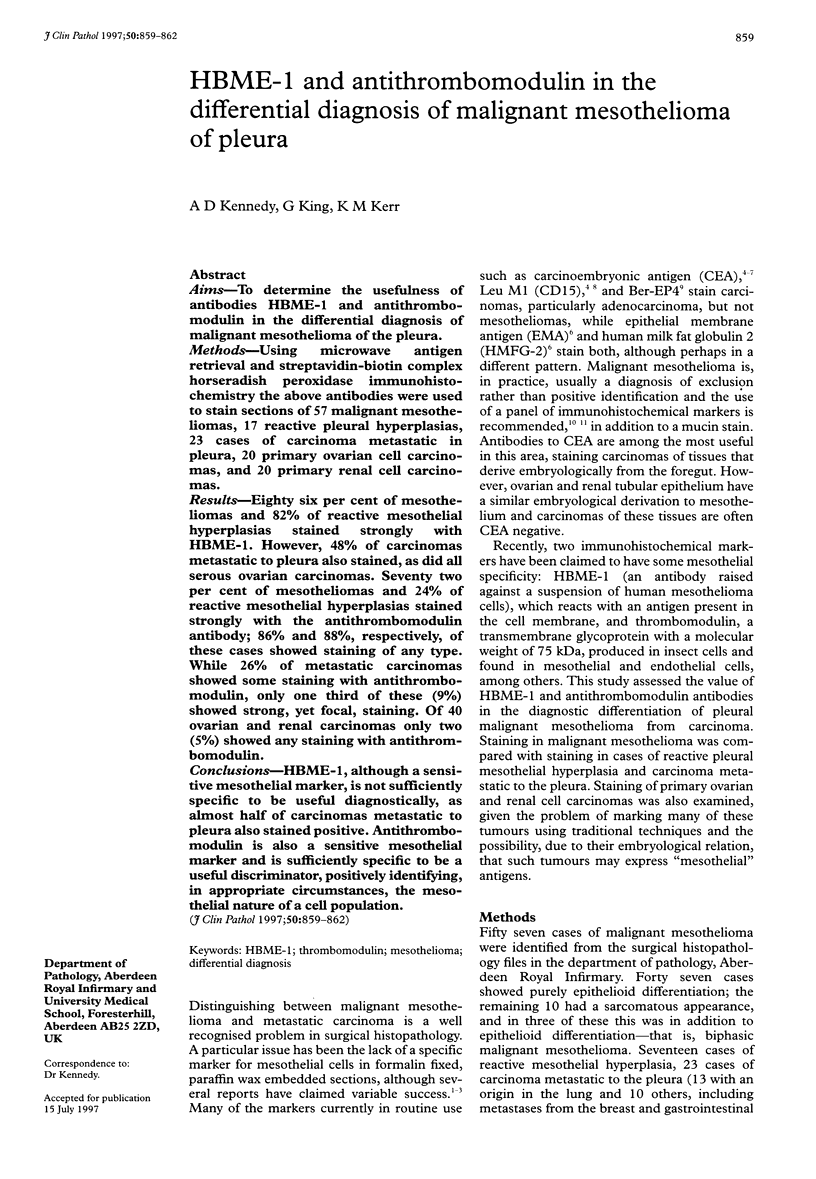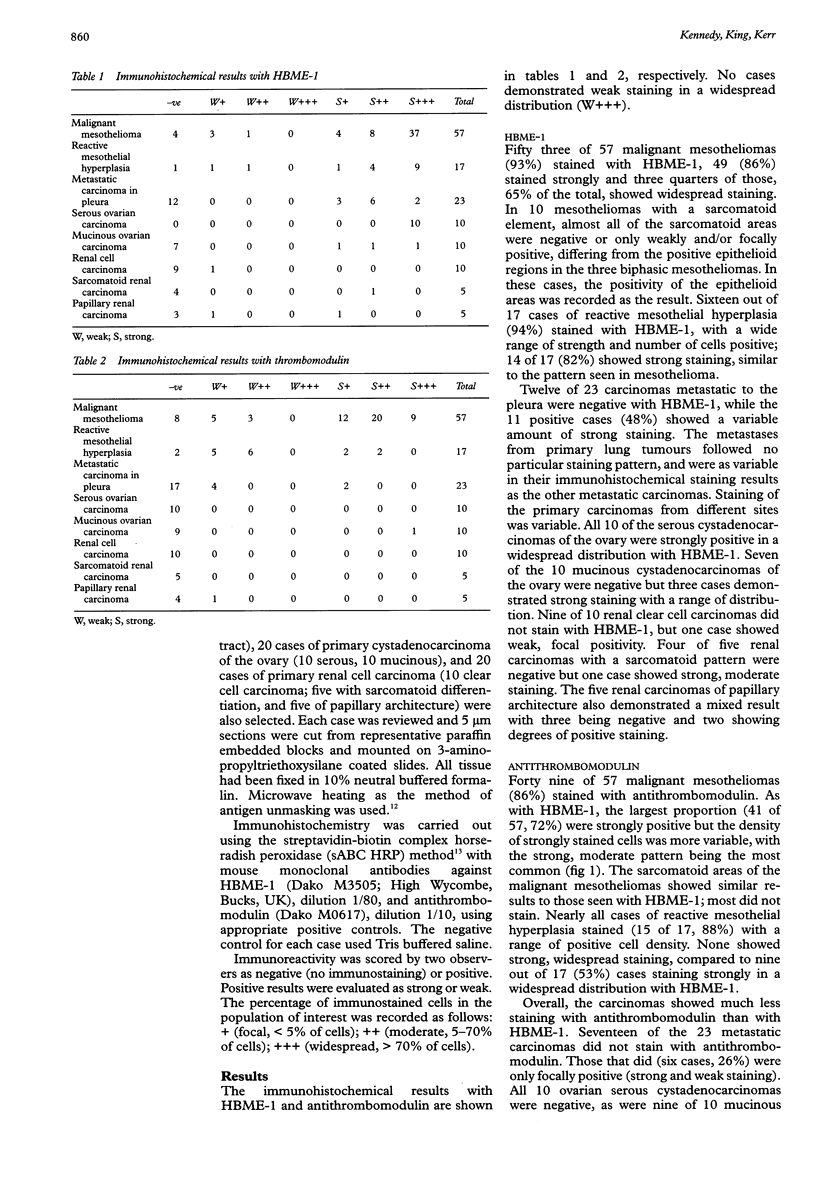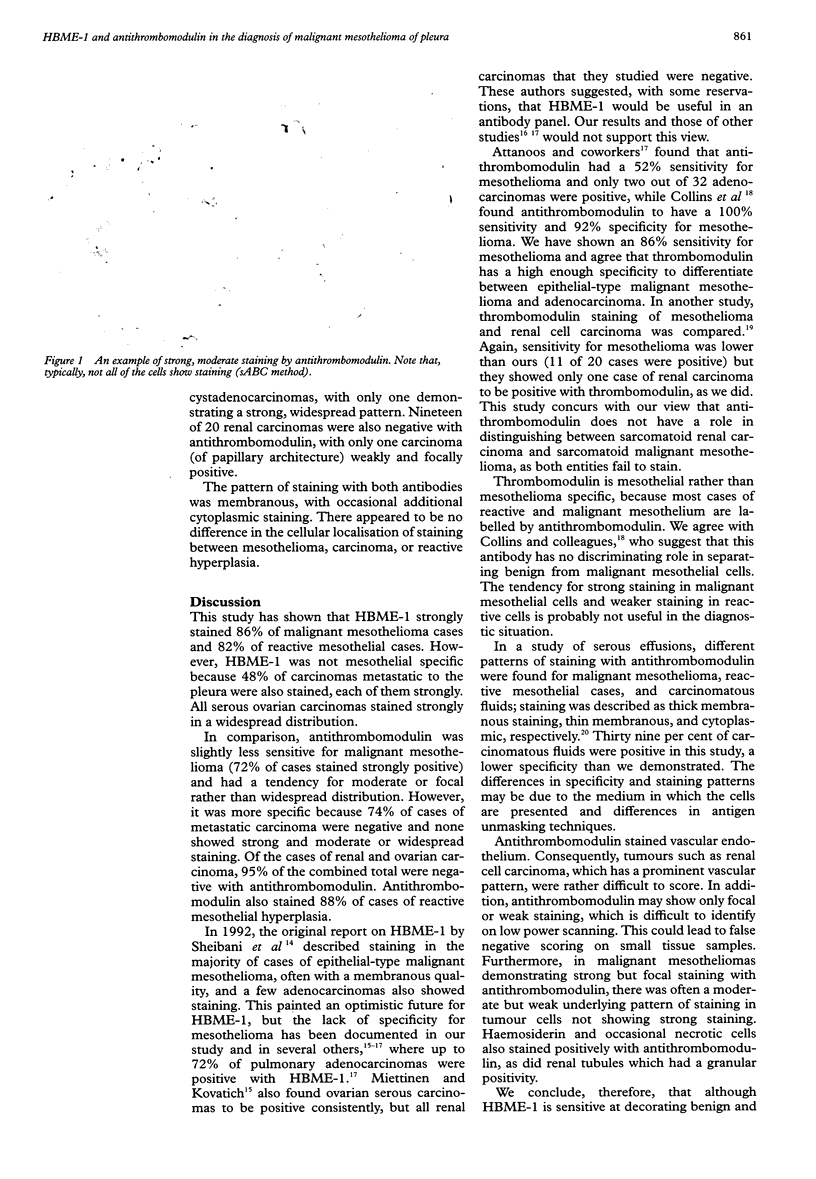Abstract
AIMS: To determine the usefulness of antibodies HBME-1 and antithrombomodulin in the differential diagnosis of malignant mesothelioma of the pleura. METHODS: Using microwave antigen retrieval and streptavidin-biotin complex horseradish peroxidase immunohistochemistry the above antibodies were used to stain sections of 57 malignant mesotheliomas, 17 reactive pleural hyperplasias, 23 cases of carcinoma metastatic in pleura, 20 primary ovarian cell carcinomas, and 20 primary renal cell carcinomas. RESULTS: Eighty six per cent of mesotheliomas and 82% of reactive mesothelial hyperplasias stained strongly with HBME-1. However, 48% of carcinomas metastatic to pleura also stained, as did all serous ovarian carcinomas. Seventy two per cent of mesotheliomas and 24% of reactive mesothelial hyperplasias stained strongly with the antithrombomodulin antibody; 86% and 88%, respectively, of these cases showed staining of any type. While 26% of metastatic carcinomas showed some staining with antithrombomodulin, only one third of these (9%) showed strong, yet focal, staining. Of 40 ovarian and renal carcinomas only two (5%) showed any staining with antithrombomodulin. CONCLUSIONS: HBME-1, although a sensitive mesothelial marker, is not sufficiently specific to be useful diagnostically, as almost half of carcinomas metastatic to pleura also stained positive. Antithrombomodulin is also a sensitive mesothelial marker and is sufficiently specific to be a useful discriminator, positively identifying, in appropriate circumstances, the mesothelial nature of a cell population.
Full text
PDF



Images in this article
Selected References
These references are in PubMed. This may not be the complete list of references from this article.
- Ascoli V., Scalzo C. C., Taccogna S., Nardi F. The diagnostic value of thrombomodulin immunolocalization in serous effusions. Arch Pathol Lab Med. 1995 Dec;119(12):1136–1140. [PubMed] [Google Scholar]
- Attanoos R. L., Goddard H., Gibbs A. R. Mesothelioma-binding antibodies: thrombomodulin, OV 632 and HBME-1 and their use in the diagnosis of malignant mesothelioma. Histopathology. 1996 Sep;29(3):209–215. doi: 10.1111/j.1365-2559.1996.tb01393.x. [DOI] [PubMed] [Google Scholar]
- Attanoos R. L., Goddard H., Thomas N. D., Jasani B., Gibbs A. R. A comparative immunohistochemical study of malignant mesothelioma and renal cell carcinoma: the diagnostic utility of Leu-M1, Ber EP4, Tamm-Horsfall protein and thrombomodulin. Histopathology. 1995 Oct;27(4):361–366. doi: 10.1111/j.1365-2559.1995.tb01527.x. [DOI] [PubMed] [Google Scholar]
- Bateman A. C., al-Talib R. K., Newman T., Williams J. H., Herbert A. Immunohistochemical phenotype of malignant mesothelioma: predictive value of CA125 and HBME-1 expression. Histopathology. 1997 Jan;30(1):49–56. doi: 10.1046/j.1365-2559.1996.d01-562.x. [DOI] [PubMed] [Google Scholar]
- Brown R. W., Clark G. M., Tandon A. K., Allred D. C. Multiple-marker immunohistochemical phenotypes distinguishing malignant pleural mesothelioma from pulmonary adenocarcinoma. Hum Pathol. 1993 Apr;24(4):347–354. doi: 10.1016/0046-8177(93)90080-z. [DOI] [PubMed] [Google Scholar]
- Cibas E. S., Corson J. M., Pinkus G. S. The distinction of adenocarcinoma from malignant mesothelioma in cell blocks of effusions: the role of routine mucin histochemistry and immunohistochemical assessment of carcinoembryonic antigen, keratin proteins, epithelial membrane antigen, and milk fat globule-derived antigen. Hum Pathol. 1987 Jan;18(1):67–74. doi: 10.1016/s0046-8177(87)80196-x. [DOI] [PubMed] [Google Scholar]
- Collins C. L., Ordonez N. G., Schaefer R., Cook C. D., Xie S. S., Granger J., Hsu P. L., Fink L., Hsu S. M. Thrombomodulin expression in malignant pleural mesothelioma and pulmonary adenocarcinoma. Am J Pathol. 1992 Oct;141(4):827–833. [PMC free article] [PubMed] [Google Scholar]
- Coutinho H. B., King G., Sewell H. F., Tighe P., Coutinho V. B., Robalinho T. I., Carvalho A. B. Immunocytochemical study of Peyer's patches follicular-associated epithelium in the marsupial, Didelphis albiventris. Dev Comp Immunol. 1993 Nov-Dec;17(6):537–548. doi: 10.1016/s0145-305x(05)80009-6. [DOI] [PubMed] [Google Scholar]
- Doglioni C., Dei Tos A. P., Laurino L., Iuzzolino P., Chiarelli C., Celio M. R., Viale G. Calretinin: a novel immunocytochemical marker for mesothelioma. Am J Surg Pathol. 1996 Sep;20(9):1037–1046. doi: 10.1097/00000478-199609000-00001. [DOI] [PubMed] [Google Scholar]
- Edwards C., Oates J. OV 632 and MOC 31 in the diagnosis of mesothelioma and adenocarcinoma: an assessment of their use in formalin fixed and paraffin wax embedded material. J Clin Pathol. 1995 Jul;48(7):626–630. doi: 10.1136/jcp.48.7.626. [DOI] [PMC free article] [PubMed] [Google Scholar]
- Holden J., Churg A. Immunohistochemical staining for keratin and carcinoembryonic antigen in the diagnosis of malignant mesothelioma. Am J Surg Pathol. 1984 Apr;8(4):277–279. doi: 10.1097/00000478-198404000-00004. [DOI] [PubMed] [Google Scholar]
- Ordóez N. G. The immunohistochemical diagnosis of mesothelioma. Differentiation of mesothelioma and lung adenocarcinoma. Am J Surg Pathol. 1989 Apr;13(4):276–291. [PubMed] [Google Scholar]
- Sheibani K., Battifora H., Burke J. S. Antigenic phenotype of malignant mesotheliomas and pulmonary adenocarcinomas. An immunohistologic analysis demonstrating the value of Leu M1 antigen. Am J Pathol. 1986 May;123(2):212–219. [PMC free article] [PubMed] [Google Scholar]
- Sheibani K., Esteban J. M., Bailey A., Battifora H., Weiss L. M. Immunopathologic and molecular studies as an aid to the diagnosis of malignant mesothelioma. Hum Pathol. 1992 Feb;23(2):107–116. doi: 10.1016/0046-8177(92)90231-q. [DOI] [PubMed] [Google Scholar]
- Sheibani K., Shin S. S., Kezirian J., Weiss L. M. Ber-EP4 antibody as a discriminant in the differential diagnosis of malignant mesothelioma versus adenocarcinoma. Am J Surg Pathol. 1991 Aug;15(8):779–784. doi: 10.1097/00000478-199108000-00008. [DOI] [PubMed] [Google Scholar]
- Skov B. G., Lauritzen A. F., Hirsch F. R., Skov T., Nielsen H. W. Differentiation of adenocarcinoma of the lung and malignant mesothelioma: predictive value and reproducibility of immunoreactive antibodies. Histopathology. 1994 Nov;25(5):431–437. doi: 10.1111/j.1365-2559.1994.tb00004.x. [DOI] [PubMed] [Google Scholar]
- Skov B. G., Lauritzen A. F., Hirsch F., Nielsen H. W. The histopathological diagnosis of malignant mesothelioma v. pulmonary adenocarcinoma: reproducibility of the histopathological diagnosis. Histopathology. 1994 Jun;24(6):553–557. doi: 10.1111/j.1365-2559.1994.tb00575.x. [DOI] [PubMed] [Google Scholar]
- Skov B. G., Stahel R. A., Hirsch F. ME1-antibody labelling of primary bronchogenic tumours and extrapulmonary malignancies. Lung Cancer. 1994 Sep;11(3-4):221–227. doi: 10.1016/0169-5002(94)90542-8. [DOI] [PubMed] [Google Scholar]



